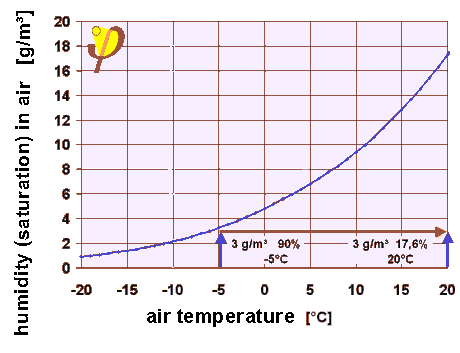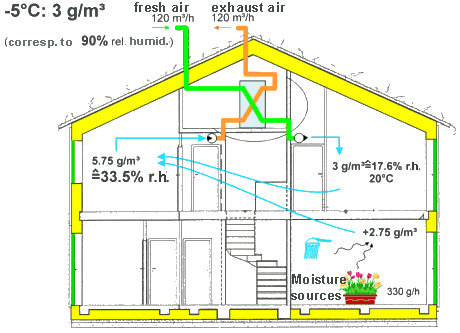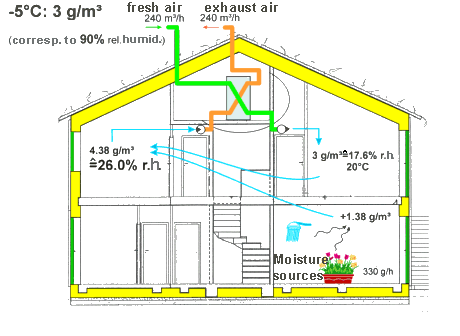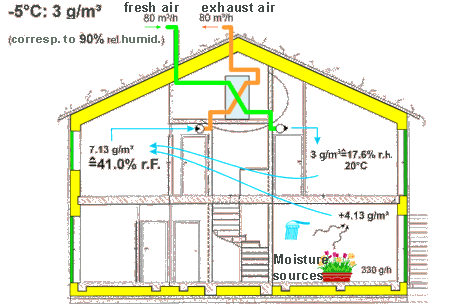|
The higher the fresh air rate, the lower the indoor relative humidity.
A simple way to keep relative humidity higher during winter times is to reduce the fresh air rates. An exhaust rate of 80 m³/h (2826 ft³/h) corresponding to 20 m³/h/Person is still sufficient for acceptable indoor air quality (see measurement results in different Passive Houses). With a fresh air rate of 80 m³/h the indoor relative humidity will be approx. 41%. The air change rate, however, will be reduced to some 0.25 h-1, but this will be sufficient - because there is a guaranteed continues flow of fresh air into the building. |
| Ventilation
and moisture - The relative humidity of indoor air is particularly dependent on:
Water vapor from indoor sources of humidity is diluted by the incoming fresh air. The greater the volume of incoming fresh air, the lower the indoor relative humidity. It does not make a difference whether the fresh air is provided by infiltration, opened windos or a ventilation system (as long as there is no (de-)humification). And it does not make a difference whether the incoming air is heated (e.g. by heat recovery) - becaues this will not change the total mass of the humidity in the air flow. This dilution effect is particularly pronounced in winter, because cold outdoor air contains very little humidity (e.g., there are only 3 g of water per m³ air at -5°C(23°F)/90% relative humidity). When this air is brought inside and warmed to 20°C (68°F), it's relative humidity is only 17.6%, before additional moisture is added by indoor sources. With "normal" household sources (330 g/h - varies) and "normal" ventilation (e.g., 120 m³/h (4238 ft³/h), from German Industry Standard "DIN 1946") this example would result in a relative humidity of 33.5%. In general, this value will be comfortable as long as the air is reasonably clean (free of dust). In cases where ventilation is within standards, but occupants still perceive the air as too dry, decreasing the fresh air supply volume is an easy fix. The decrease in volume of fresh air causes the humidity to increase, because moisture from interior sources is diluted less. If the fresh air supply in the above example is decreased to 80 m³/h (2826 ft³/h), which is well within acceptable limits for acceptable indoor air quality, the indoor humidity will increase to 41%. Nobody should be forced to a ventilation rate which is higher than necessary and gives reason for a relative humdity which is perceived to be too low. Conventional design tends toward higher rates of ventilation. In the past, air change rates as high as 0.5 or even 0.8 ach were considered necessary to keep interior humidity in winter low enough to discourage the development of condensation, which can cause mildew and damage to building components. But this risk does not exist in a Passive House, anyhow. Elements of the buildings envelope are so well insulated that interior surfaces are too warm for condensation to occur even at 60% relative humidity; and moisture barriers and air seals prevent moist inside air from reaching building elements that could cool it to below the dew point. Therefore, the fresh air volume can be lower, particularly when occupants perceive the humidity as being too low. "Appropriate" air change rates for residences are between 0.3 and 0.4. For passive houses, we generally recommend leaning toward the lower rate. This keeps the indoor air quality good, while maintaining a comfortable humidity and maximizing energy savings. Summarizing solutions to fix too low indoor air humidity:
Keep the home as free of dust as possible: clean often with a good vacuum cleaner having a fine dust filter and make sure the ventilation air filtration (if any) is working properly. Incidentally, air that is practically dust-free does not feel "too dry" even if it contains very little moisture; people feel very comfortable in cold air at high elevations (where there is very little dust). Since the air in a residence cannot be kept free of dust with reasonable effort, there is a practical lower limit to relative humidity (about 30%) below which most occupants consider air too dry. When that point is reached, solutions 1. and/or 2. above should be used. If the flow of fresh air to maintain an acceptable indoor air quality will be higher than what is accepted with regard to "dry air" conditions, additional separate air humidifies can be used. These appliances have to be cleaned at regular intervals. The presentation of Ruedi Krisi at the 10th conference on Passive Houses will intruduce innovative so called "enthalpy-heat-exchangers", which recover not only heat, but a part of the humidity as well. This is a link to the basic facts about Passive Houses. (updated:
2006-03-03
W. Feist - thanks
to Kent Lion for translation |


 With
a higher ventilation rate (240 m³/h) the indoor
moisture sources will be diluted to a higher extend. Now the relative
humidity will be reduced to approx. 27%. Most people will perceive
that as "too dry". A fresh air rate of 60 m³/h per
person therefor is too much of the good one, giving a too low relative
humidity. (air change rate approx 0.75 h-1).
With
a higher ventilation rate (240 m³/h) the indoor
moisture sources will be diluted to a higher extend. Now the relative
humidity will be reduced to approx. 27%. Most people will perceive
that as "too dry". A fresh air rate of 60 m³/h per
person therefor is too much of the good one, giving a too low relative
humidity. (air change rate approx 0.75 h-1).